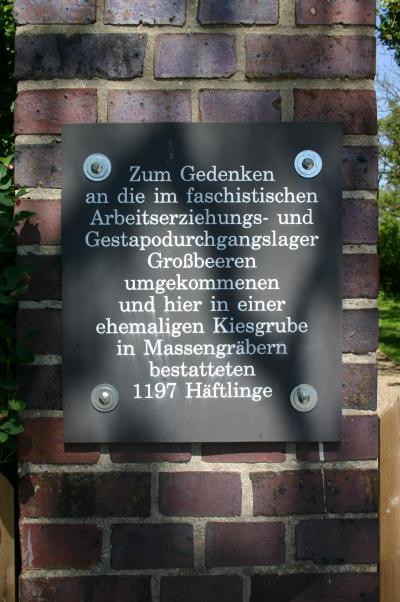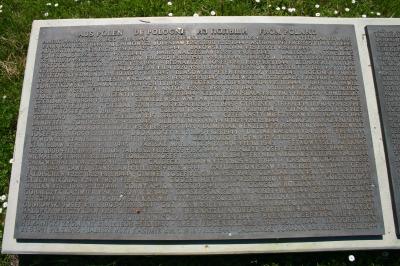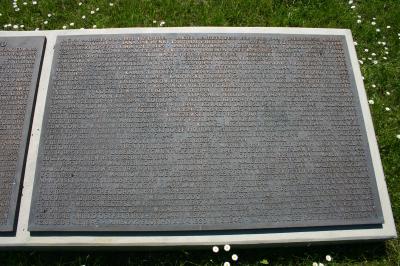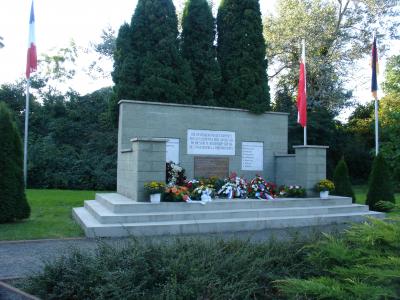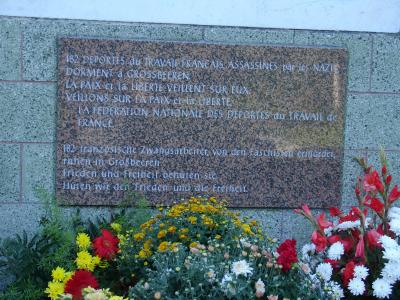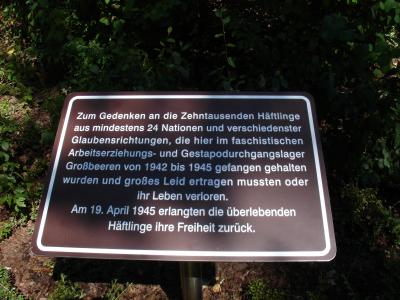Großbeeren
Between 1942 and April 1945, there were about 25,000 convicts in the camp, most of whom were Russians, Poles, French and Czechs. These people performed the heaviest unpaid work for the Third Reich, suffering from insufficient food rations (reducing portions was one of the punishments), beatings and torture with long hours of roll calls under the watchful eye of 60 SS guards. Divided into work units, they worked on the construction of railway lines, shelters, sewers, streets and roads. A large part of them worked directly for the arms industry at Daimler-Benz aircraft engine plants in Genshagener Heide. The prisoners' work was also used seasonally on large nearby farms. At the end of the war the Landesschützen squad – uniformed and armed civil defence units, replaced the SS guards. Three days before the entry of the Red Army, the camp command escaped, leaving about a thousand prisoners in the camp.
On the left pillar of the entrance gate to the cemetery of camp victims, there is a plaque with an inscription in German:
In memory of 1,197 prisoners who died in the fascist Gestapo transitional camp Grossbeeren and were buried in mass graves in a former gravel pit.
[translated from Polish]
The exact number of Großbeeren victims is unknown, but the official burial list includes 1,197 names of victims from England, Belgium, Belarus, Bulgaria, Croatia, Denmark, Greece, France, Spain, the Netherlands, Yugoslavia, Lithuania, Latvia, Germany, Poland, Serbia, Slovakia, Turkey, the Soviet Union, Ukraine, Hungary and Italy. The list also includes 11 names without any nationality provided, defined as stateless (Staatenlose), including 4 Polish-sounding names.
The deceased or murdered young men aged 17 to 30 were initially buried in the camp premises; 200 victims were buried by the wall of the local cemetery. Over time and with increasing mortality, the deceased were buried near the cemetery in a former gravel pit, which had previously served as a waste dump. From 1946 to 1949, a memorial site was created at the location of the mass graves in the former gravel pit - initially in the form of a cemetery with a monument erected in 1951 - rebuilt in 1967. The once forgotten and neglected necropolis gained a new look in the 1990s. The main alley leads to the monument. Along the alley, on both sides, there are several metal plates with the names of the people buried here. In the central part of the monument, there is a plaque with the following inscription in German:
The society of the district of Zossen commemorates the victims of fascism and militarism resting in this sacred place.
[translated from Polish]
Consecutive plates bear the names of the countries and the number of victims from them, including 334 Polish opponents of Nazism.
An additional plaque with the following inscription was officially unveiled in September 2002:
POMIĘDZY 1942 I 1945 ROKIEM W BYŁYM OBOZIE [MM1] PRACY WYCHOWAWCZEJ GROSSBEEREN ZMARŁO 1289 WIĘŹNIÓW Z 25 KRAJÓW. OKOŁO 210 ZNALAZŁO TUTAJ MIEJSCE OSTATNIEGO SPOCZYNKU. ICH NAZWISKA ZOSTAŁY UWIECZNIONE W MIEJSCU PAMIĘCI.
[BETWEEN 1942 AND 1945, 1,289 PRISONERS FROM 25 COUNTRIES DIED IN THE FORMER GROSSBEEREN WORK EDUCATION CAMP. THIS IS THE PLACE OF FINAL REST OF ABOUT 210 OF THEM. THEIR NAMES HAVE BEEN IMMORTALISED AT THE MEMORIAL SITE.]
[MM1]W polskiej wersji jest tutaj literówka: „OBZIE“.
Poprawiłam ją tutaj, ale wolę zaznaczyć, bo być może taka literówka jest faktycznie na tablicy pamiątkowej…
